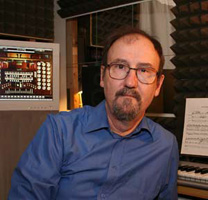Hauptwerk Virtual Pipe Organ
"The X-Keys USB Stick serves to instantly activate one of my three favourite pre-set Combinations in Hauptwerk."- Jukka Laaksonen, Organist, Helsinki, Finland
"The device is now an integral part of a two-manuals and a full two-and-half-octave-pedal organ setup, which I use for practicing church music (mainly J. S. Bach, my favourite composer). Then the actual performance will be in a church, using a real acoustic instrument."
Learn more about Hauptwerk Virtual Pipe Organ here: hauptwerk.com
Many thanks to Jukka Laaksonen for sharing his story, images, and sounds with us.
X-keys Stick Controlling Hauptwerk
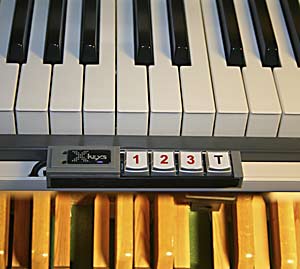
Jukka Laaksonen's Setup
When played, these two rehearsal manuals and the pedalboard produce MIDI information, which is then interpreted into music in an iMac, running a software calledHAUPTWERK (by Milan Digital Audio Company, USA). It contains real recorded acoustical audio samples of each and every pipe in a great pipe organ. When they play together, it sounds VERY authentic, and in my mind I am immediately transferred to a nearby church.
This picture shows the layout of my manuals and pedals, including the black rear volume (swell) pedal, which is absolutely essential in creating credible church organ music electronically.
Test Drive and X-keys XK-4 Stick Today
Our 30 day, no questions asked return policy lets you evaluate an X-keys Stick risk free. If you are not impressed by its performance, return it for a full refund.
Switching Combinations
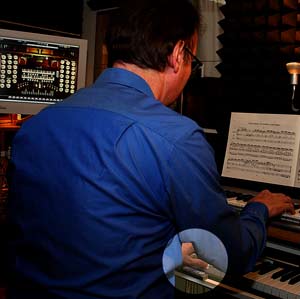
Here is the X-Keys Stick in action. When you first start selecting the sound color for a given musical number in a large pipe organ, you connect together individual pipe rows (RANKS) inside the cabinet, by pulling the wooden stops in the front of the instrument (in modern organs, they can also be electronic switches). Each sum of individual ranks playing together at one time, selected by the organist, is called a COMBINATION.
The pipe organ as a musical instrument relies heavily on the use of STEP DYNAMICS, where you can instantly move from silent sound to loud sound, or vice versa. Pulling the stops by hand, while playing music at the same time, would be far too slow and cumbersome, so most organs have a series of pre-set Combination Memory Switches between the manuals, which the musician can then gently activate with his free thumb (while the other fingers just keep playing the music). Most of my favourite organs here in Finland have four Combinations.
So, in my home setup, the X-Keys USB Stick serves to instantly activate one of my three favourite pre-set Combinations in Hauptwerk organs: 1, 2 or 3. The last one is called T. It means TUTTI, which is Italian for "all". It means that all the stops are open and the organ plays out at full blast, really loud (which is great for wedding marches and Postludiums, but not necessarily so great for burial ceremonies or hymns).
Hauptwerk Display
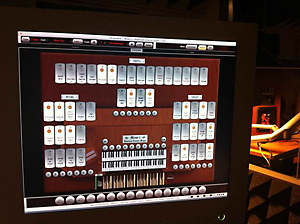
This is a picture of the Hauptwerk computer screen beside the organ, where I can see at all times, which stops are open and which are closed. It also gives me a secondary, visual confirmation that the Stick USB switches actually work, when the organ stops jump into new positions on the screen (not that I ever doubted that in the first place :)
Building a Monster Pipe Organ
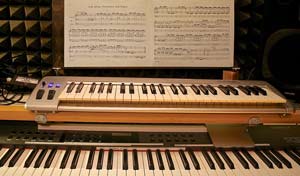
This is an example of how easy (and cheap) it is to build a monster-sounding pipe organ, using only everyday items from the local music store. The lower keyboard (GREAT) is a Samick KK-1 Master Keyboard, whereas the upper helper manual (SWELL) is a smaller plastic M-AUDIO Keystation 49e. If I ever want to add another manual, in order to play the biggest multi-manual Hauptwerk models, I simply stack another M-AUDIO Keystation 88 (160 Euros) on top of the existing ones. Any cheap keyboard will do, really. They do not even need to be velocity-sensitive (although my Samick is), since in a traditional, electrically triggered pipe organ mechanism, there simply is no such thing as touch sensitivity (well, in a purely mechanical keying action there is, but to a very small degree).
The Studio
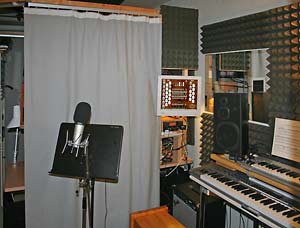
This is an overall picture of my home studio, with the vocalist microphone and the Hauptwerk organ.
Please use high-quality headphones or big loudspeakers to play this file:
This recording was played by me, in my home studio with Hauptwerk. It was recorded directly into a stereo WAV file inside the iMac.
To say that “it sounds real”, is an understatement. IT IS REAL.
In the beginning of this recording, you can hear the silent sound of the electric air blower motor, running steadily below the airbox (yes, they recorded that, too), and when you virtually pull the wooden taps on screen to change registrations, you can actually hear the pneumatic valves closing and opening inside the pipe cabinet, ten feet above your head. It is almost scary...
In this recording, I play the organ choral “Christ lag in Todesbanden” by Johann Sebastian Bach. It tells about Easter and how Christ died for us, and is based on an old German hymn.
This recording gives the listener an idea of Hauptwerk and what this amazing computer application is capable of. It actually sounds like a CD recording of a large pipe organ. Virtual reality, nothing less!
The real-life organ, from which these pipe samples were originally recorded, is still located in St. Anne´s Chapel in Moseley, Britain, and was built by the Brindley and Foster Organ Company from London. It comes free with every Hauptwerk purchase.
In addition, there are literally hundreds of different organs that you can buy online from Hauptwerk and other websites (the downloads cost 200 to 300 USD each). I, with my rather limited funds, have bought only three additional organs so far, but even they give me great tonal variation and enough rank registration possibilities to rehearse through all my organ repertoire, and then some.

